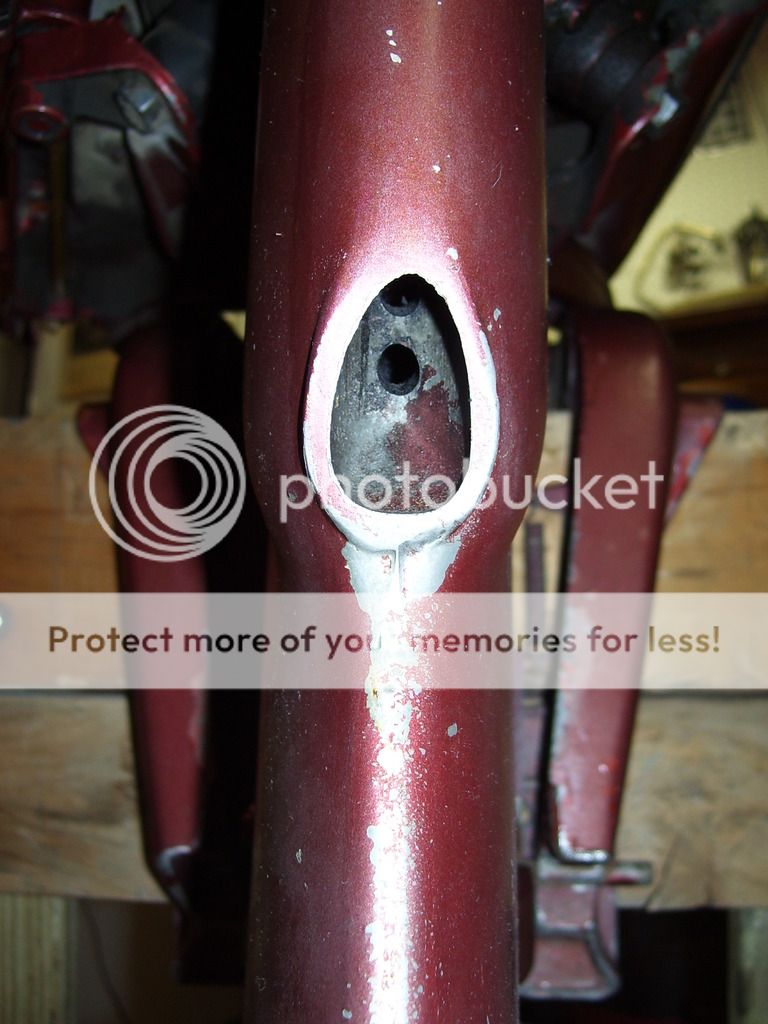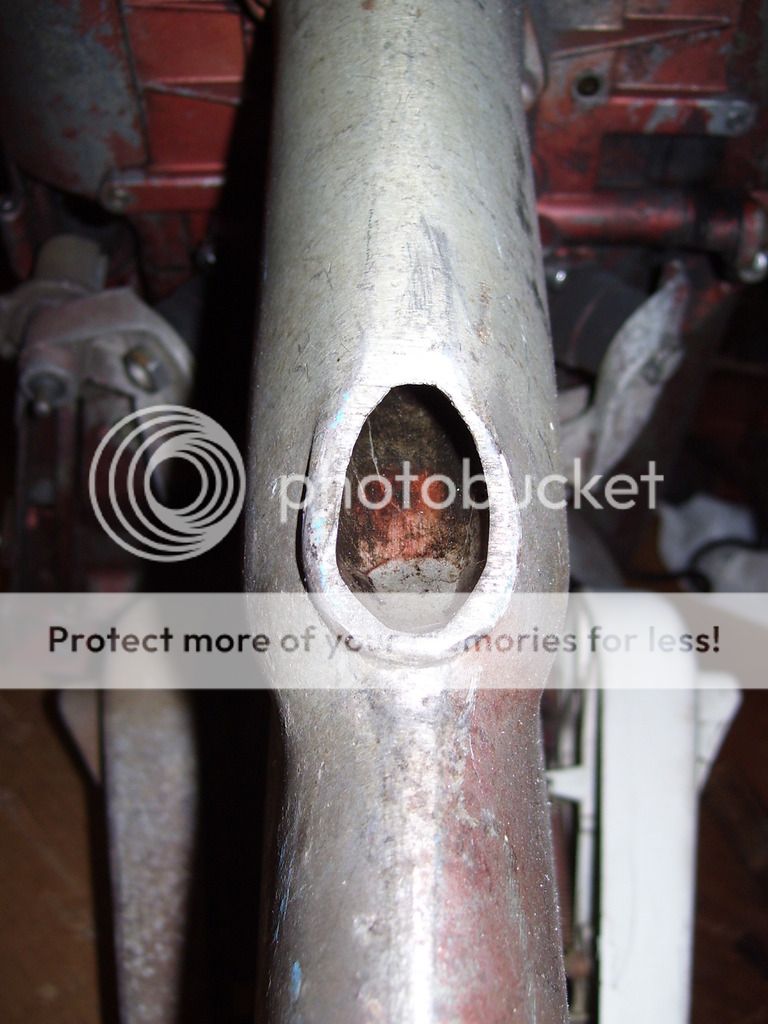Home › Forum › Ask A Member › RDE-18 powerhead to exhaust plate/gaskets
- This topic has 62 replies, 13 voices, and was last updated 5 years, 9 months ago by
 outboardnut.
outboardnut.
-
AuthorPosts
-
February 5, 2017 at 9:47 pm #52465
When OMC was working on a replacement for there 22 horse power apposed twins, Johnson was upgrading there 22 cubic inch 15 horse while Evinrude was upgrading there 27 cubic inch 17 horse Sportfour. The Evinrude four cylinder 25 horse was heaver and more expensive to build and actually did not run any smoother than Johnsons twin so the bean counters decided to repackage Johnson’s design as the Evinrude Big Twin. This design had entirely separate exhaust and driveshaft housings. Minor improvements were made until the 1954 aqua sonic development proved quiet motors sold well. The 1955 Big Twins (& johnson RDs) were the epitome of quiet. However average power output dropped 5%. Testing found air was being restricted from the carburetor and a service bulletin was issued to correct the problem.
Unfortunately I no longer have any service bulletins prier to 1958. The bulletin instructed you to open the quarter inch hole in the front lower motor cover to two inches, and remove and discard the rubber elbow and fiberglass accustical liner from the intake air silencer. Also long term use found the new one piece Exhaust & driveshaft housing was, despite the baffles, allowing moisture into the lower crankshaft seal area and rusting some crankshafts. The sound restricting tubes were removed from the top of the idle relief chamber, leaving it with a flat cover. The lower bearing seal was changed and a bulletin was issued about greasing the spline at the top of the driveshaft.
In 1956 the exhaust baffle was added and the tubes came back on the exhaust relief chamber. In ’57 the exhaust baffle plate was removed. Again grease on the driveshaft spline was emphasized. We still see some motors with rusty crankshafts. Some with driveshafts impossible to remove, others where the splines are completely rusted away and the crankshaft turns and the drive shaft doesn’t. . . 😉

 February 5, 2017 at 10:04 pm #52467
February 5, 2017 at 10:04 pm #52467The SS plate was used in conjunction with the oil seal as mentioned. The idea behind it was to divert as much water/exhaust as possible from getting back up into the powerhead. They tossed the idea, obviously, and went back to the carbon seal setup. The carbon seal is better, but has its faults as well. It is by no means perfect. The carbon body cracks probably 4 times out of 10. Also, the o ring in the carbon seal does not last very long due to the heating/cooling cycles it undergoes. Very rare you find one not dry rotten and cracked. I’m not a fan of them either. If you have one, I would recommend changing the o ring every 5 years or unless you have the powerhead off sooner, then change it out. Cheap insurance.
Drilling the lower pan to at least 2 inches helps ALOT. I would recommend this to anyone with a lower pan with the small 1/4" hole. You will notice a great performance improvement.
February 5, 2017 at 10:07 pm #52468The tubes you see at the top of the idle relief chamber are sound restriction tubes. The cavity that the plate covers simply drops down into the exhaust cavity and gearcase. I do not see a reason for them, in fact, they allow moisture up into the powerhead. Probably reason they were removed and the flat plate used eventually. Use the flat plates if you have your motor apart. Drilling holes into the chamber keep it cool I would imagine. I have never had the reason to drill the holes myself.
February 5, 2017 at 10:12 pm #52469Garry,
I too am a firm believer in re greasing the splines EVERY time that gearcase is dropped. I have seen a lot of guys working on their gearcase,. and then just slide it back on up without changing the o ring or cleaning/regreasing the splines. Just lazy in my opinion. I really like the BLUE BRP grease for this, seems to stick well and not get washed away.
February 5, 2017 at 10:18 pm #52470No the holes would have had to be drilled according to the instructions in the POOP hole located in the lower leg on the outside of the engine were the exhaust and water comes out of the engine at idle. Another way to describe would be like you stuck your little finger in the exhaust to give it a rectal exam. It instructed to drill the holes inside the exhaust hole through the wall of the leg to vent the exhaust . If you look straight forward in the above water exhaust there would be a row of 1/4” holes hand drilled if it was modified. That’s why I did not do it.
February 5, 2017 at 11:13 pm #52476I have a Field Repair Kit p/n #277598 with instruction sheet #304683. I could copy and send you an email of it.
Ed
edbevsam@yahoo.comFebruary 5, 2017 at 11:32 pm #52477Billy, The 1956 motor from Idaho HAS a two 1/4 inch holes drilled in the poop hole! That motor also had no baffle, a single gasket between the powerhead and the exhaust housing AND had the small blank plate. So that motor has been modified! Here is a photo.

My parts motor does not have any drilling at the poop hole. It came with a baffle, two gaskets above and below the baffle, and the plate with the tubes. It is unmodified! Here is a photo.

Also I have an operating 1956 RJE-18. It has also been drilled, with two 1/4" holes at the poop hole.
Just as a side note, I have an RD-12, RD-15A and a 1954 Evinrude 25HP. These motors all have two smaller (around 0.170 inch) holes in the same poop hole location, apparently from the factory.
Thank you so much everyone. I will put the motor together w/o the baffle and with the small blank plate same as I found it. What an incredible club!
February 5, 2017 at 11:53 pm #52479Hello Ed,Is that Kit the flat plate and instructions to drill as I said? If so could you post it here? I am sure it would be of interest. The leg all the way down inside is open to the engine ports so I did not really see a reason use the flat plate I figured if it ran all those years with the plate with the 2 tubes I would just replace with a good 2 tube part. I will mention one more thing about my 30 HP. I mentioned earlier in this thread that my power head was seized when I started to redo it. That was my fault.Years before I carried it down the basement because I thought I was storing it better but what I did wrong was I carried it down the steps by myself with the power head hanging down and the prop up. What I did not know was the water drain hole was plugged up on the lower unit and there was some water in it and it drained into the open ports of the engine and after many years the cylinders and pistons seized up. Many years later I found out and was just sick about it. Luckily I got a great 30 HP. power head off eBay for $75.00 very low hours. My original engine was whipped out so it was a blessing in disguise. So don’t carry your engine down basement upside down. Maybe I can save a motor here. Bill,
February 6, 2017 at 12:52 am #52480So should we be drilling those holes or leaving it be?
http://www.richardsoutboardtools.com
classicomctools@gmail.comFebruary 6, 2017 at 1:13 am #52483I did not use the flat plate change over kit I bought that required drilling. I replaced the original deteriorated 2 tube plate with a good used one. Obviously the engines will run good either way ( 60 years ). I was afraid to use my kit but I learned today it is fine to use it with no harm if I so choose.
-
AuthorPosts
- You must be logged in to reply to this topic.

